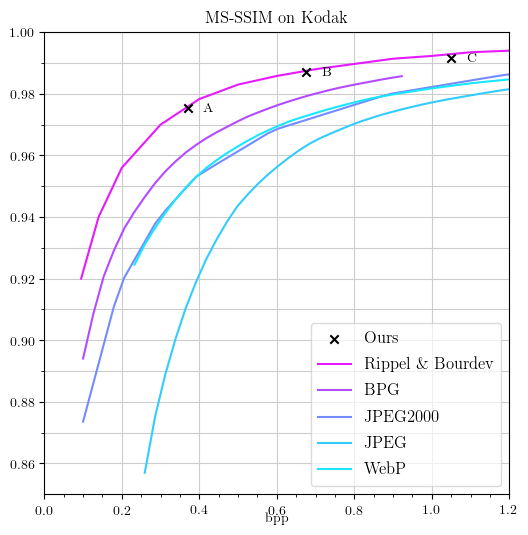Conditional Probability Models for Deep Image Compression
[Paper] [Citation]
TensorFlow implementation of Conditional Probability Models for Deep Image Compression, published in CVPR 2018.
Prerequisites
- Download checkpoints here and extract them to
ckpts - Python 3 (tested with Python 3.4.5)
- TensorFlow (tested with tensorflow-gpu version 1.4.1)
- Python packages as specified by requirements.txt (
pip install -r requirements.txt) - A CUDA-compatible GPU
Inference
NOTE: Inference only works on CUDA-compatible GPUs.
To do inference, use the following command
python val.py ../ckpts MODEL_ID DATASET --save_ours
where MODEL_ID is one of
0515_1103: Point A in the plot (on Kodak: bpp: 0.370, MS-SSIM: 0.975)0515_1309: Point B in the plot (on Kodak: bpp: 0.677, MS-SSIM: 0.987)0515_1310: Point C in the plot (on Kodak: bpp: 1.051, MS-SSIM: 0.992)
and DATASET is either the path to a directory of png files or an escaped glob (e.g., some/images/\*/\*.jpg). All
images readable with PIL should be supported.
This will save outputs in ckpts/MODEL_ID\ DATASET/imgs and display the mean bpp and MS-SSIM on console.
Detailed measures per image are written to ckpts/MODEL_ID\ DATASET/measures.csv. Note that some images may be padded.
Encoding to bitstream
By default, val.py will use cross entropy to estimate the actual bitrate. In our experiments, this is very close to
the real bitrate (<0.1% difference for most images). But to evaluate this yourself, you can use
python val.py ../ckpts MODEL_ID DATASET --save_ours --real_bpp
which will use an arithmetic encoder to write the symbols of an image to a file, count the number of bits, and then decode the bits to restore the symbols. We note that this is not optimized at all (images from the Kodak validation set take ~350s to encode and ~200s to decode). For a practical implementation, the following should be done:
- A faster arithmetic encoder should be used (we use the clean but non-optimized code from here).
- The probability classifier network should output the logits for all symbols in parallel, instead of sequentially.
- Decoding should re-use activations, as in Fast PixelCNN++, which achieves speedups of up to 183x.
- Like in classical approaches, the image could be split into blocks and those blocks could be encoded in parallel.
Plot
The plot above was created using
python plotter.py ../ckpts 0515_1103,0515_1309,0515_1310 kodak --style mean --ids A B C --latex
For reference, the curve corresponding to our model in Fig. 1 in the paper can be reproduced with the following data:
# bpp -> MS-SSIM on Kodak
CVPR_FIG1 = [
(0.1265306, 0.9289356),
(0.1530612, 0.9417454),
(0.1795918, 0.9497924),
(0.2061224, 0.9553684),
(0.2326531, 0.9598574),
(0.2591837, 0.9636625),
(0.2857143, 0.9668663),
(0.3122449, 0.9695684),
(0.3387755, 0.9718446),
(0.3653061, 0.9738012),
(0.3918367, 0.9755308),
(0.4183673, 0.9770696),
(0.4448980, 0.9784622),
(0.4714286, 0.9797252),
(0.4979592, 0.9808753),
(0.5244898, 0.9819255),
(0.5510204, 0.9828875),
(0.5775510, 0.9837722),
(0.6040816, 0.9845877),
(0.6306122, 0.9853407),
(0.6571429, 0.9860362),
(0.6836735, 0.9866768),
(0.7102041, 0.9872690),
(0.7367347, 0.9878184),
(0.7632653, 0.9883268),
(0.7897959, 0.9887977),
(0.8163265, 0.9892346),
(0.8428571, 0.9896379)]
Training
If you want to train on the ImageNet dataset as described in the paper, follow the steps below (Prepare ImageNET). After doing
this,
you can pass --dataset_train imgnet_train --dataset_test imgnet_test to train.py (make sure you set $RECORDS_ROOT for this,
see below). Otherwise, set --dataset_train and --dataset_test
to an escaped glob matching images files (e.g. some/images/\*/\*.jpg).
python train.py ae_configs/cvpr/AE_CONFIG pc_configs/cvpr/PC_CONFIG \
--dataset_train TRAIN_DATASET \
--dataset_test TEST_DATASET \
--log_dir_root LOG_DIR_ROOT
where AE_CONFIG and PC_CONFIG are one of the configs in the respective folders. The models in ckpts where
obtained with the following configs:
0515_1103:ae_configs/cvpr/lowpc_configs/cvpr/res_shallow0515_1309:ae_configs/cvpr/medpc_configs/cvpr/res_shallow0515_1310:ae_configs/cvpr/highpc_configs/cvpr/res_shallow
Various options are available for train.py, such as --restore to continue training from a previous checkpoint.
See python train.py -h.
Prepare ImageNET
The following instructions assume that you have the following tools installed:
- GNU parallel (you can do without but it might take a really long time. Installing should be as simple as
(wget -O - pi.dk/3 || curl pi.dk/3/ || fetch -o - http://pi.dk/3) | bash, see e.g. here) - ImageMagick to downscale images to 256 pixels
fjcommon(pip install fjcommon) to create TF Records
Note that creating all records will likely take several hours. Note that the following was tesed using zsh.
1. Get ImageNET, in the proper format
You need to download ILSVRC2012_img_train.tar and ILSVRC2012_img_val.tar (a good resource is the
Inception download_imagenet.sh script). For the following instructions, we assume both tar files are located in a directory data.
# in data/
mkdir train val
pushd train
tar xvf ../ILSVRC2012_img_train.tar
popd
pushd val
tar xvf ../ILSVRC2012_img_val.tar
popdThis will unpack to 1000 .tar containers into train/ and 50000 .JPEG images into val/. Now, we need to extract the
training images. This may take a while depending on your setup.
# in data/
pushd train
find . -name "n*.tar" | parallel -j64 'mkdir -vp {/.} && tar xf {} -C {/.}'
popd2. Downsample
We downsample each image to have 256 pixels on the shorter side, by executing the following command in data/. Again,
this is very time-consuming, so if you have access to some CPU cluster, it might make sense to run it there.
# in data/
find . -name "*.JPEG" | parallel -j64 convert -verbose {} -resize "256x256^" {}3. Create records
Now it's time to pack the images into TF record files. We will save them in data/records/:
# in data/
mkdir -p records/train
mkdir -p records/val
pushd train
find . -name "*.JPEG" | parallel --bar -j64 -N 1250 \
'OUTPUT_PATH=$(printf "../records/train/train-%05d.tfrecord" {#});' \
'python -m fjcommon tf_records mk_img_rec {} -o $OUTPUT_PATH --feature_key image/encoded'
popd
pushd val
find . -name "*.JPEG" | parallel --bar -j16 -N 1250 \
'OUTPUT_PATH=$(printf "../records/val/val-%05d.tfrecord" {#});' \
'python -m fjcommon tf_records mk_img_rec {} -o $OUTPUT_PATH --feature_key image/encoded'
popd4. Set RECORDS_ROOT
Make sure the following environment variable is set before running train.py:
export RECORDS_ROOT=path_to_data/recordsCitation
If you use this code for your research, please cite this paper:
@inproceedings{mentzer2018conditional1,
Author = {Mentzer, Fabian and Agustsson, Eirikur and Tschannen, Michael and Timofte, Radu and Van Gool, Luc},
Booktitle = {Proceedings of the IEEE Conference on Computer Vision and Pattern Recognition (CVPR)},
Title = {Conditional Probability Models for Deep Image Compression},
Year = {2018}}

